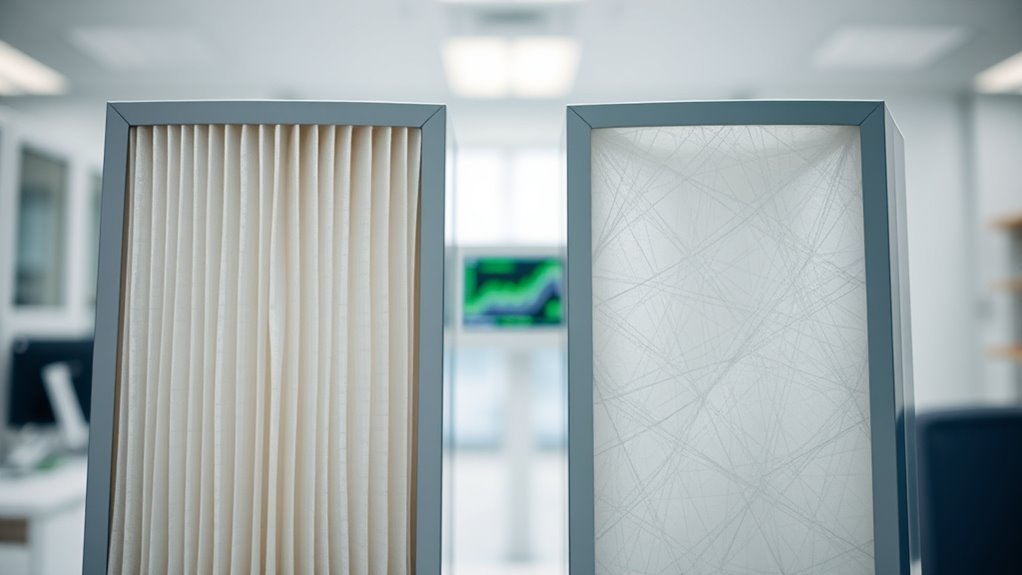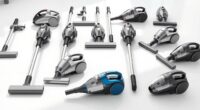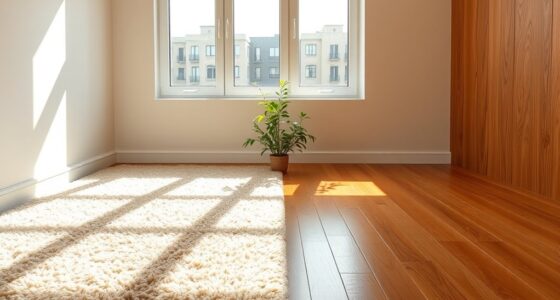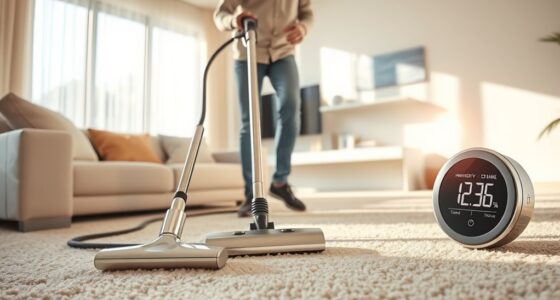If you have severe allergies, ULPA filters are the better choice because they capture even tiny airborne particles as small as 0.12 microns, offering superior purification compared to HEPA filters. While ULPA filters provide more effective allergen removal, they are also more expensive and require careful handling. If you’re curious about balancing efficiency, cost, and maintenance, you’ll find useful details as you explore further options.
Key Takeaways
- ULPA filters capture smaller particles (down to 0.12 microns), providing superior protection for severe allergy sufferers.
- HEPA filters effectively trap common allergens like pollen and pet dander, making them suitable for most allergy needs.
- ULPA filters require more frequent maintenance and specialized handling due to their dense construction and higher filtration capacity.
- HEPA filters are more widely available, easier to replace, and generally more cost-effective than ULPA filters.
- For extreme allergies and environments with tiny airborne contaminants, ULPA offers the highest level of filtration efficiency.

Are HEPA and ULPA filters really that different, or are they just variations of the same technology? While they both serve to improve air quality by trapping microscopic particles, understanding their differences is key when choosing the right filter for severe allergies. Air purification efficiency is a major factor here. HEPA filters are designed to trap at least 99.97% of particles as small as 0.3 microns, which includes common allergens like pollen, pet dander, and dust mites. ULPA filters take this a step further, capturing 99.999% of particles down to 0.12 microns, making them highly effective against even the tiniest airborne contaminants. If your allergies are severe, ULPA filters might offer better protection because of their superior air purification efficiency.
However, the level of filtration isn’t the only consideration. Filter maintenance requirements also play a vital role. HEPA filters generally need replacing every 6 to 12 months, depending on usage and air quality. They tend to clog over time as they trap particles, so regular replacement guarantees peak performance. ULPA filters, being more dense and efficient, can also require more frequent maintenance and careful handling during replacement. Since they trap more particles, they might clog faster if used in environments with high pollutant levels, and improper handling can release trapped dust or allergens back into the air. Additionally, filter lifespan can vary greatly depending on environmental conditions and usage patterns.
Choosing between HEPA and ULPA filters also involves considering the practicality of maintenance. HEPA filters are more widely available and easier to source, and their replacement process is straightforward. ULPA filters, on the other hand, are usually more expensive and may need specialized handling and disposal due to their dense construction. This means your ongoing maintenance requirements could be higher in terms of cost and effort with ULPA filters, even though they provide superior filtration.
Frequently Asked Questions
How Often Should HEPA and ULPA Filters Be Replaced?
You should check your filter’s lifespan regularly to determine the best replacement schedule. Typically, HEPA filters need replacing every 6 to 12 months, while ULPA filters may last 1 to 2 years, depending on usage and air quality. Keep an eye on airflow and performance; if airflow decreases or you notice persistent allergies, it’s time for a replacement. Regular maintenance guarantees maximum filtration and healthier indoor air.
Are ULPA Filters Safe for Home Use?
ULPA filters are safe for home use if you maintain good indoor air quality and follow proper filter maintenance. They effectively trap tiny particles, making them great for severe allergies. Just guarantee you replace or clean the filter as recommended by the manufacturer, usually every few months. Proper maintenance prevents issues like airflow reduction or mold growth, ensuring your home stays safe and allergen-free with ULPA filters in use.
Can HEPA Filters Remove Viruses Effectively?
Imagine a tiny army patrolling your air, catching invisible enemies. HEPA filters excel at this, boasting high air filtration efficiency and strong virus removal capabilities. They trap particles as small as 0.3 microns, including many viruses. While no filter can guarantee 100% virus elimination, HEPA filters substantially reduce airborne pathogens, creating a safer environment. Trust their power to clear the air of harmful viruses effectively and breathe easier daily.
What Is the Cost Difference Between HEPA and ULPA Filters?
You’ll find that ULPA filters are generally more expensive than HEPA filters, with higher initial costs. Over time, ULPA filters tend to have a shorter filter lifespan, which can increase maintenance costs due to more frequent replacements. HEPA filters are more budget-friendly upfront and typically last longer, making them a cost-effective choice if you’re concerned about long-term expenses and maintenance.
Do ULPA Filters Produce Any Harmful Byproducts?
You might worry that ULPA filters produce harmful byproducts, but that’s unlikely. They use high-quality filter material designed to trap tiny particles, and chemical emissions are minimal because ULPA filters don’t rely on chemicals or additives. Instead, they physically capture allergens and pollutants, so you can trust they won’t release dangerous substances. Proper maintenance guarantees they operate safely, making ULPA filters a safe choice for severe allergy sufferers.
Conclusion
Think of your air purifier as a guardian, shielding you from invisible invaders. HEPA filters are like sturdy castles, blocking most allergens and keeping you safe. ULPA filters, on the other hand, are like impenetrable fortresses, stopping even the tiniest threats. Choosing between them is like selecting the right armor—your comfort and health depend on it. Trust in the right filter to be your loyal shield, turning your home into a haven of pure, breathable air.









